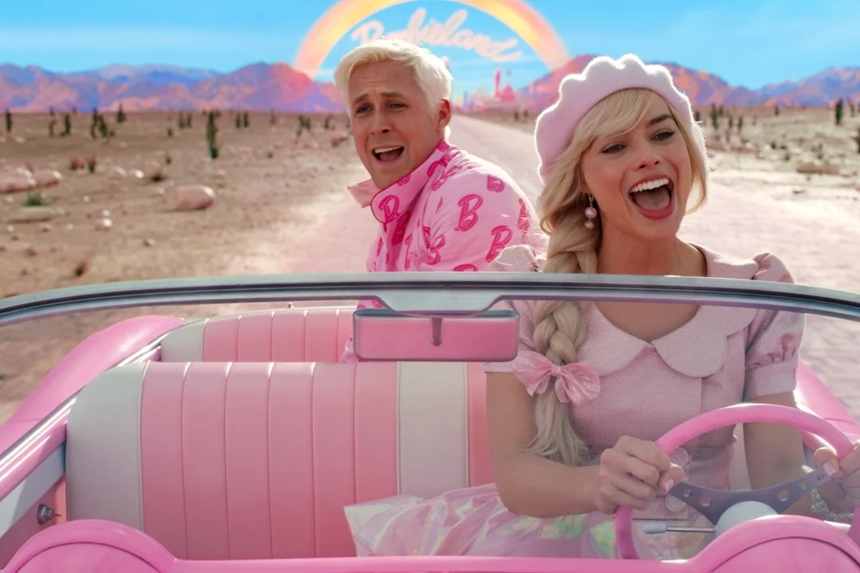It’s a Barbie world, and for director Greta Gerwig, who is making Barbie relevant again, the box office numbers capture the air of celebration surrounding her newest work. In its first weekend, Barbie grossed $155 million at the box office, making it the 24th highest-grossing film for its first weekend. Co-written by Gerwig and her partner Noah Baumbach, the film boasts a star-studded cast, vibrant sets, sparkly outfits, and captivating dance numbers, creating the perfect vessel to hold Gerwig and Baumbach’s brilliant writing.
Barbie, the “Original Teenage Fashion Model” invented by Ruth Handler in 1959, was the first of its kind. Before Barbie, young girls were largely limited to playing with baby dolls and subsequently confined to envisioning their futures as mothers. Barbie would soon grow into one of the most recognizable brands in history. Today, Mattel sells over 100 Barbie dolls a minute and a Barbie Dreamhouse every two minutes. With such major cultural impact, it was only logical for the doll to take to the silver screen.
In the style of Stanley Kubrick’s 2001: A Space Odyssey (1968), the film’s opening scene introduces Barbie to a group of young girls content with their baby dolls. Once Barbie emerges, the girls begin to smash their dolls in favor of the tall, blonde, alluring Barbie.
Every morning, Barbie, played by Margot Robbie, wakes up in her perfect world of Barbieland. She walks to her closet, where her clothes magically switch from pajamas to her perfectly stylish, perfectly pink daytime outfit before she fetches breakfast. Barbie opens her fridge, which is not filled with food but rather a large sticker of perishables and a few cartoonishly oversized cartons of juice and milk. These details emulate the kitchens one would find in any Barbie Dreamhouse. After breakfast, Barbie floats from the top floor of her Dreamhouse to her car (because no child really walks their Barbie down the stairs), waves to her neighbors, and begins her perfect day.
In Barbieland, women run the world. They are all Barbies, and all men are Kens, with a few exceptions: Barbie’s pregnant friend Midge (who the narrator [Helen Mirren] adds was discontinued by Mattel because a pregnant Barbie is just “weird”), Barbie’s sister Skipper, and Ken’s friend Allan (Michael Cera). The president, supreme court justices, physicists, authors, and astronauts are all Barbies. The Kens have essentially no power. The cast is both racially diverse and trans-inclusive in a film that celebrates womanhood for all.
But soon, Barbie begins to malfunction: Her feet fall flat from their naturally pointed state, she develops cellulite, and she begins contemplating death. Weird Barbie (Kate McKinnon) tells her she must enter the real world to repair her relationship with the girl playing with her. When a child plays with a Barbie and grows sad, those thoughts can infiltrate the Barbies in Barbieworld, causing them to malfunction. Ken (Ryan Gosling) joins Barbie as she enters reality and develops human consciousness.
Before her journey to Los Angeles, Barbie thought that all issues of gender equality had been solved. She’s in for a rude awakening when, upon her arrival in California, she is immediately sexualized and berated. Ken discovers the patriarchy and is infected with thoughts of toxic masculinity.
Gerwig fearlessly examines the controversial culture surrounding Barbie, complicating her role as an icon and role model. The script pokes fun at Mattel for being a company that only cares about profit and not the well-being of young girls. This struck me as odd, considering the whole film is essentially one large marketing tactic that has already successfully invigorated the fading brand.
For years Barbie sales have been steadily in decline. In 1991, Mattel sold over a billion dollars’ worth of Barbies. In 2015, gross sales of Mattel’s Barbie brand reached $905 million, roughly 10 percent down from its 1991 height. The same year, Time ran a story titled “Bye, Bye, Barbie: 2015 Is the Year We Abandon Unrealistic Beauty Ideals.” The doll’s unrealistic physical proportions plagued Barbie’s reputation. Mattel also sold a doll called Growing Up Skipper, with breasts that would grow when the “slender” doll’s arm was raised. For years, Barbie contributed to a toxic culture of dieting in an effort to obtain an idealized figure: a small waist with sizable breasts. A 1965 “Slumber Party” outfit set came with a pink cardboard scale with a featured weight of 110 lbs. and a “How to Lose Weight” book.
Turning the brand around was no small feat. Over the past few years, Barbie has released dolls with larger bodies, different heights, and disabilities, supporting the brand’s redemption. But the new inclusive lines could not, alone, compensate for the brand’s bad image in the new era of size diversity. Gerwig still had quite a bit to answer for on behalf of Mattel.
Gerwig has, miraculously, threaded that needle, creating an emotional, meticulously crafted film that unpacks womanhood, self-actualization, hyper-femininity, and accessible presentations of feminism. While it is difficult to ignore the film’s corporate politics, Barbie is not, in terms of artistry, dissimilar to Gerwig’s other notable projects: Little Women (2019), Lady Bird (2017), and Frances Ha (2012).
Do not miss this instant classic. And if you see it in theaters, don’t forget to wear pink.
Become a Saturday Evening Post member and enjoy unlimited access. Subscribe now



